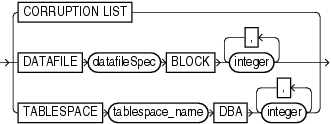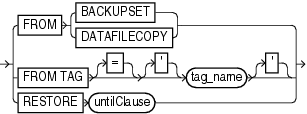| Oracle® Database Backup and Recovery Reference 10g Release 2 (10.2) Part Number B14194-03 |
|
|
View PDF |
| Oracle® Database Backup and Recovery Reference 10g Release 2 (10.2) Part Number B14194-03 |
|
|
View PDF |
Syntax
blockrecover::=

bmrBlockSpec::=

bmrOption::=

Purpose
Block media recovery recovers an individual data block or set of data blocks within a datafile. This type of recovery is useful if the data loss or corruption applies to a small number of blocks rather than to an entire datafile.
Typically, block corruption is reported in error messages in trace files. Block-level data loss usually results from:
I/O errors causing minor data loss
Memory corruptions that get flushed to disk
You can either use BLOCKRECOVER CORRUPTION LIST to recover all blocks reported in the V$DATABASE_BLOCK_CORRUPTION view, or specify the datafile number and block number or the tablespace and data block address (DBA) when executing the BLOCKRECOVER command.
Restrictions and Usage Notes
The target database must be mounted or open. You do not have to take a datafile offline if you are performing block media recovery on it.
You can only perform complete media recovery of individual blocks. Point-in-time recovery of individual data blocks is not supported.
You can only perform block media recovery on corrupt blocks.
Blocks marked media corrupt are not accessible until recovery completes.
You cannot perform block media recovery when using a backup control file.
You cannot use proxy backups to perform block media recovery. If the only backups that you have are proxy backups, then you can restore them to a nondefault location on disk, which causes RMAN to view the restored files as datafile copies. You can then use the datafile copies for block media recovery.
You must have a full backup of the file containing the corrupt blocks: block media recovery cannot use incremental backups.
If RMAN fails to access a specific archived redo log file needed for block media recovery, it performs restore failover, trying all other backups listed in the RMAN repository that are suitable for use in this operation, and only fails if no suitable backup is available. See Oracle Database Backup and Recovery Advanced User's Guide for details on restore failover.
Block media recovery cannot survive a missing or inaccessible archived log, although it can sometimes survive missing or inaccessible records (Oracle Database Backup and Recovery Advanced User's Guide).
The datafile header block (block 1) cannot be recovered.
You cannot perform block media recovery in NOARCHIVELOG mode.
Keywords and Parameters
blockrecover
| Syntax Element | Description |
|---|---|
DEVICE TYPE deviceSpecifier |
Specifies the device type for the backup used in the block recovery.
See Also: "deviceSpecifier" |
bmrBlockSpec
| Syntax Element | Description |
|---|---|
bmrBlockSpec |
Specifies the data blocks that require recovery. |
CORRUPTION LIST |
Recovers all blocks listed in the V$DATABASE_BLOCK_CORRUPTION view. This view displays blocks marked corrupt by the most recent BACKUP (with or without the VALIDATE option), VALIDATE, or CREATE CATALOG command. The following types of corruption result in rows added to this view:
|
DATAFILE datafileSpec |
Specifies a list of one or more datafiles that contain blocks requiring recovery.
See Also: "datafileSpec" |
BLOCK integer |
Specifies the block number of the block requiring media recovery. Typically, the block number is obtained from error message output. |
TABLESPACE tablespace_name |
Specifies the tablespace name or number containing the corrupt blocks. |
DBA integer |
Specifies the data block address (DBA) of the corrupt block. |
bmrOption
| Syntax Element | Description |
|---|---|
bmrOption |
Specifies various restore options relating to the block recovery. |
FROM BACKUPSET |
Indicates that only backup sets should be restored. |
FROM DATAFILECOPY |
Indicates that only datafile image copies should be restored. |
FROM TAG= 'tag_name' |
Indicates that only the copy of the backup with the specified tag should be restored. Tag names are not case sensitive.
See Also: "BACKUP" to learn how a tag is applied to a copy of a backup. |
RESTORE untilClause |
Specifies that only backups and copies created before the specified time, SCN, or log sequence number should be restored.
See Also: "untilClause" |
Examples
Recovering a Group of Corrupt Blocks: Example This example recovers corrupt blocks in three datafiles:
BLOCKRECOVER DATAFILE 2 BLOCK 12, 13 DATAFILE 3 BLOCK 5, 98, 99 DATAFILE 4 BLOCK 19;
Limiting Block Media Recovery by Type of Restore: Example The following example recovers a series of blocks and restores only from datafile copies:
RUN
{
BLOCKRECOVER DATAFILE 3 BLOCK 2,3,4,5 TABLESPACE sales DBA 4194405, 4194409, 4194412
FROM DATAFILECOPY;
}
Limiting Block Media Recovery by Backup Tag: Example This example recovers blocks and restores only from the backup with the tag weekly_backup:
BLOCKRECOVER TABLESPACE SYSTEM DBA 4194404, 4194405 FROM TAG "weekly_backup";
Limiting Block Media Recovery by Time: Example The following example recovers two blocks in the SYSTEM tablespace. It restores only from backups that could be used to recover the database to a point two days ago:
BLOCKRECOVER TABLESPACE SYSTEM DBA 4194404, 4194405 RESTORE UNTIL TIME 'SYSDATE-2';
Repairing All Block Corruption in the Database: Example The following example runs a backup validation to populate V$DATABASE_BLOCK_CORRUPTION, then repairs any corrupt blocks recorded in the view:
BACKUP VALIDATE DATABASE; BLOCKRECOVER CORRUPTION LIST;